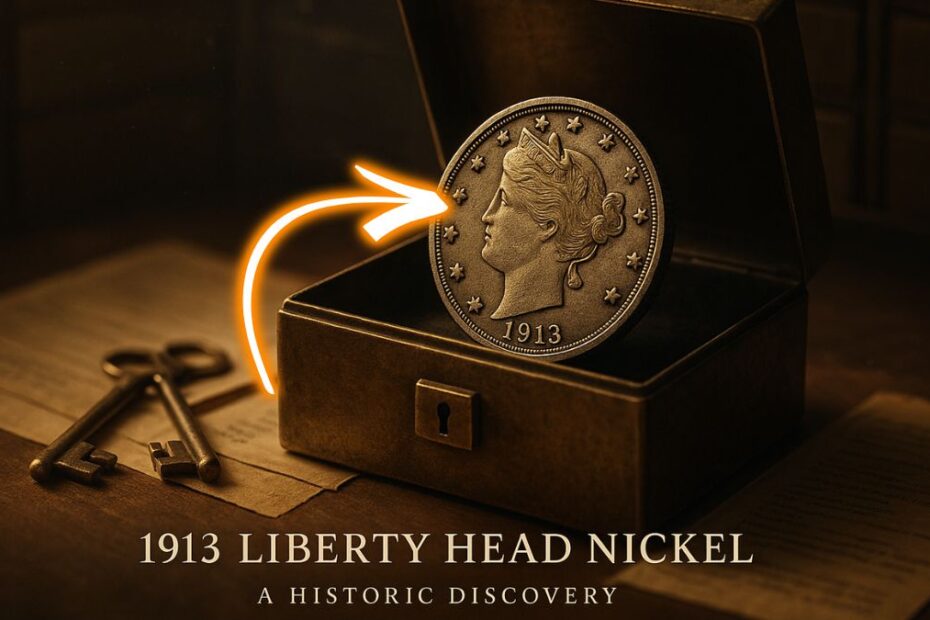In the realm of rare coins, few pieces command as much attention as the 1913 Liberty Head Nickel. With only five known examples in existence, their back-story is shrouded in mystery, intrigue and high-stakes value.
One particular specimen — stored quietly in a safe-deposit box for decades — recently made numismatic history.
This article delves into every detail of that discovery: when, how, why it matters, the figures, the facts, and the legacy of this legendary coin.
The Background of the 1913 Liberty Head Nickel
The 1913 Liberty Head Nickel is unique because it was not officially authorised by the United States Mint. Standard records list no Liberty Head nickels minted in 1913; that year the design was changed to the Buffalo (Indian Head) nickel.
Yet five coins dated 1913 with the Liberty Head design emerged, sparking a lifetime of speculation among collectors.
Here are some key facts:
- Only 5 specimens have been confirmed.
- They first came to public attention in 1919-1920 when collector Samuel W. Brown advertised for them and exhibited them.
- Two of the five reign in museum collections; the other three are privately held.
- These coins are among the most expensive ever sold: one fetched over US $4.2 million in 2022.
The Discovery in the Safe Deposit Box
One of these five coins — known as the “Walton specimen” after its long-time owner George O. Walton — was discovered under unusual circumstances. Walton had kept his coin collection in safe-deposit boxes in places such as Charlotte and Roanoke.
In 1962, Walton tragically died in a car crash while en route to a coin show, and it was believed that his collection (including the 1913 Liberty Head Nickel) had been lost or destroyed.
However, the coin was later found stored in a strongbox in a closet of his sister’s home in Virginia, neglected and mistaken for a fake for decades.
In July 2003 the piece was formally authenticated and recognised as the long-missing fifth specimen.
Table of Key Facts and Figures
| Item | Detail |
|---|---|
| Coin | 1913 Liberty Head Nickel |
| Number Known | 5 specimens |
| Specimen Name | Walton specimen (among others: Eliasberg, Olsen, Norweb, McDermott) |
| Initial Acquisition (Walton) | circa 1945 for US $3,750 by George O. Walton |
| Disappearance/Storage | Believed lost in 1962 crash; stored in closet for ~40 years |
| Authentication Date | July 2003 at the American Numismatic Association (ANA) convention in Baltimore |
| Auction Sale | April 25 2013 for US $3,172,500 |
| Latest Known Sale | October 2022 for US $4.2 million (Walton specimen) |
| Authenticity Confirmation | Graded by Professional Coin Grading Service (PCGS) as PR63 for Walton specimen |
Why This Discovery Matters
There are several reasons this particular find is historic:
- Rarity and provenance – With just five known examples, any new or re-discovered specimen immediately becomes a highlight.
- Dramatic back-story – The vault/safe-deposit box-style storage, the car crash, decades of neglect, and eventual authentication make it cinematic and enthralling to coin-collecting audiences.
- Price escalation – The Walton specimen’s dramatic jump from US $3,750 in the 1940s to over US $4 million by 2022 illustrates the long-term value of ultra-rare coins.
- Educational value – The story highlights the importance of records, authentication, storage, opportunity and patience in numismatics.
- Market impact – Such a discovery attracts media attention outside pure numismatics, broadening interest in rare-coin collecting.
The Authentication Journey
After the coin was held in the family’s closet for decades, the chain of events leading to its recognition was as follows:
- A nationwide hunt was launched in 2003 offering a reward for the missing fifth specimen.
- At the ANA World’s Fair of Money in Baltimore (July 2003), experts compared the Walton coin side-by-side with the other four known specimens.
- The professional grading service PCGS certified it as PR63 (a proof grading for coins).
- After that, the coin entered the auction market, validated its place amongst the five true examples, and its value leapt accordingly.
Impact on the Coin-Collecting World
The story of this coin has had ripple effects:
- Collectors now revisit safe-deposit vaults, family inheritances, long-forgotten storage to look for hidden treasures.
- Auction houses leverage provenance, stories and authentication milestones to boost value.
- This case underscores the risk of mis-identification: the coin was once considered a fake and languished in obscurity.
- The value scale: from mere five-cent face value to multi-million-dollar trophy piece.
The rediscovery of the Walton specimen of the 1913 Liberty Head Nickel is one of the most remarkable tales in numismatic history. From a humble deposit box to global auction headlines, the journey underscores the enduring power of rarity, provenance and perseverance.
For coin collectors, historians and numismatists alike, this single coin captures the essence of the hobby—history in hand, patience rewarded, and value beyond face value. Its story will inspire both seasoned and new collectors for decades.
FAQs
Why was the 1913 Liberty Head Nickel never officially minted?
Because the United States Mint had already switched to the Buffalo (Indian Head) nickel design in early 1913 and Mint records show no authorised Liberty Head pieces for that year. The known examples are believed to have been struck surreptitiously.
How many of the 1913 Liberty Head Nickels are in museum collections?
Two of the five known specimens are publicly held in museum collections; the other three are privately owned.
What made the Walton specimen especially valuable?
Its dramatic back-story — safe-deposit box storage, presumed loss in a car crash, decades of obscurity, and eventual authentication — added unique provenance and mystique, which in turn increased collector demand and value.
